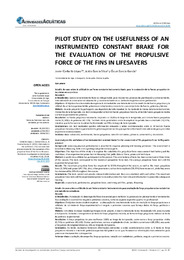Please use this identifier to cite or link to this item:
https://hdl.handle.net/11000/27537Full metadata record
| DC Field | Value | Language |
|---|---|---|
| dc.contributor.author | Carballo López, Javier | - |
| dc.contributor.author | García Silva, Antía | - |
| dc.contributor.author | García García, Óscar | - |
| dc.contributor.other | Departamentos de la UMH::Ciencias del Deporte | es_ES |
| dc.date.accessioned | 2022-07-26T06:39:16Z | - |
| dc.date.available | 2022-07-26T06:39:16Z | - |
| dc.date.created | 2022-04-29 | - |
| dc.identifier.citation | RIAA Vol. 6 Núm. 11 (2022) | es_ES |
| dc.identifier.issn | 2530-805X | - |
| dc.identifier.uri | https://hdl.handle.net/11000/27537 | - |
| dc.description.abstract | Antecedentes: Valorar el rendimiento físico es indispensable para mejorar los procesos de planificación y entrenamiento. Esta valoración es esencial en el salvamento y socorrismo tanto en su vertiente deportiva como profesional. Objetivos: El objetivo de este estudio de explorar la idoneidad de una batería de test de medición de fuerza propulsiva y la utilidad de un test experimental de potencia en salvamento y socorrismo que arroje datos de fuerza, potencia y técnica. Método: En este proyecto ha participado una deportista de talla mundial. Se ha realizado la misma batería de test en tres momentos de la temporada. Los test corresponden al test de fuerza propulsiva máxima, el test de fuerza propulsiva media y el test experimental de potencia. Resultados: La fuerza propulsiva máxima ha mejorado un 10,8% a lo largo de la temporada, así como la fuerza propulsiva media (0,74%) y la potencia (49.11%). También otros parámetros como la amplitud de patada han aumentado (38,53%), mientras que la frecuencia de aleteo ha disminuido un 25% a lo largo de la temporada. Conclusiones: Los test realizados aportan información relevante y están correlacionados entre sí. El test de fuerza propulsiva máxima y el test experimental de potencia podrían ser los que aportan información más relevante para prescribir el posterior entrenamiento. | es_ES |
| dc.description.abstract | Background: Assessing physical performance is essential to improve planning and training processes. This assessment is essential in lifesaving, both in its sporting and professional aspects. Objectives: The objective of this study is to explore the suitability of a propulsive force measurement test battery and the usefulness of an experimental power test in lifesaving that yields data on force, power and technique. Method: A world-class athlete has participated in this project. The same battery of tests has been carried out at three times of the season. The tests correspond to the maximum propulsive force test, the average propulsive force test and the experimental power test. Results: The maximum propulsive force has improved by 10.8% throughout the season, as well as the mean propulsive force (0,74%) and power (49.11%). Also, other parameters such as kick amplitude (38,53%) have increased, while frequency has decreased by 25% throughout the season. Conclusions: The tests carried out provide relevant information and they are correlated with each other. The maximum propulsive force test and the experimental power test could provide the most relevant information to prescribe subsequent training. | es_ES |
| dc.format | application/pdf | es_ES |
| dc.format.extent | 6 | es_ES |
| dc.language.iso | eng | es_ES |
| dc.publisher | Universidad Miguel Hernández de Elche | es_ES |
| dc.rights | info:eu-repo/semantics/openAccess | es_ES |
| dc.rights.uri | http://creativecommons.org/licenses/by-nc-nd/4.0/ | * |
| dc.subject | valoración | es_ES |
| dc.subject | rendimiento | es_ES |
| dc.subject | fuerza propulsiva | es_ES |
| dc.subject | natación con aletas | es_ES |
| dc.subject | potencia | es_ES |
| dc.subject | salvamento | es_ES |
| dc.subject | socorrismo | es_ES |
| dc.subject.other | CDU:796 - Deportes | es_ES |
| dc.title | Case study on the usefulness of an instrumented constant brake for the evaluation of the propulsive force of the fins in lifesavers. | es_ES |
| dc.type | info:eu-repo/semantics/article | es_ES |

View/Open:
5. Carballo_ Case study on the usefulness of an instrumented constat brake for....pdf
511,41 kB
Adobe PDF
Share:
.png)
